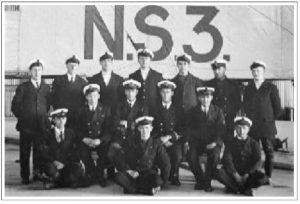Royal Air Force – Airship NS3

Charles William Printer was born into a farming family at Bulley, on the edge of the Forest of Dean, on 1 April 1895. He was the only son of the three children born to William Isaac Printer and his wife Lucretia Mary. His father died when he was four years old and at the time of the Great War his mother lived at Linden Road, Gloucester.
After leaving Sir Thomas Rich’s School, Gloucester, in January 1911 Charles entered the Royal Navy as a Boy Artificer or engineer.
Upon completion of his engineering training, he joined the Royal Naval Air Service (RNAS) and achieved the rank of Petty Officer 3 in January 1917. He transferred to the Royal Air Force in March 1918, following the merger of the RNAS with the Royal Flying Corps. He became an Airship Engineer at East Fortune Station, near Edinburgh in July 1917.
From April 1918 Airship NS3 had been carrying out escort duties in the North Sea for convoys travelling to and from Scandinavia.
At about 17.10 on 21 June 1918, it set off with a crew of ten, including Chief Engineer Printer, to escort a south bound convoy, which it located off Aberdeen at about 19.00. Just after midnight a storm blew up and with winds reaching 50 mph the airship became increasingly difficult to control due to severe turbulence. Strenuous attempts were made to make landfall and to keep the airship afloat but the severe winds drove it back out to sea. It lost pressure and hydrogen gas and eventually the stern section hit the sea at about 70 mph. The power car was ripped off and sank instantly with two engineers inside, one of whom may have been Chief Engineer Printer. The airship collapsed into the sea and five crew members were drowned; the captain plus four others survived to be picked up by a destroyer.
An officer wrote of Chief Mechanic Printer: ‘He was a very keen and clever engineer and a very hard worker, never complaining even under the most trying circumstances. It is typical of him that he carried out the orders for the engines up to the last moment with extra-ordinary promptness, although in imminent danger and this probably reduced the loss of life.’
Lost at sea, Charles William Printer is commemorated on the Hollybrook Memorial at Southampton and on the Gloucester War Memorial; he was 23 years of age.
